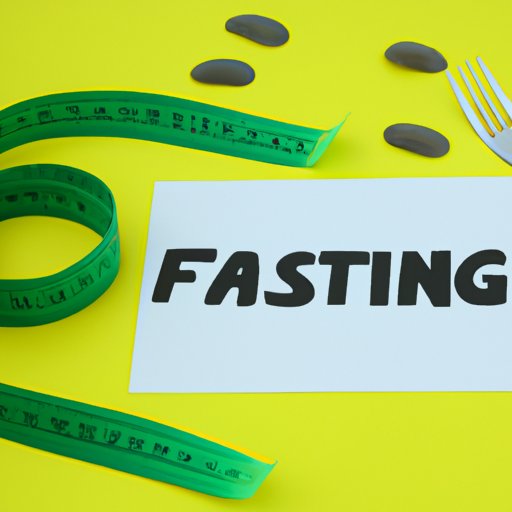
I. Introduction
Fasting has become an increasingly popular weight loss strategy over the past few years. Many people believe that skipping meals, or consuming fewer calories during certain periods, can lead to weight loss and improved overall health. But does fasting for weight loss really work, and is it safe?
In this article, we will explore the science behind fasting for weight loss, discuss how to safely incorporate fasting into a weight loss plan, weigh the pros and cons of fasting, and provide tips and success stories from those who have tried it. By the end of this article, you will have a better understanding of whether fasting is the right weight loss strategy for you.
II. The Science of Fasting: Can Skipping Meals Really Help You Lose Weight?
There are many different types of fasting, including intermittent fasting, alternate-day fasting, and extended fasting. Intermittent fasting, for example, involves limiting calorie intake for a certain period (typically 16-20 hours) and then eating during a shorter feeding window. Alternate-day fasting involves eating normally one day and then consuming only 500-600 calories on the following day. Extended fasting, on the other hand, involves abstaining from food entirely for several days at a time.
Research on fasting for weight loss is mixed. Some studies suggest that fasting can be an effective weight loss method, while others show that it may not be any more effective than traditional diets. However, evidence suggests that fasting can help with insulin sensitivity and improve metabolic health, which may increase overall weight loss success.
III. Fasting for Beginners: How to Safely Incorporate Fasting into Your Weight Loss Plan
If you’re interested in trying fasting for weight loss, it’s important to do so safely. First, consult with a healthcare professional before starting a fasting regimen. It’s also essential to be mindful of what you eat during your feeding window. Prioritize whole, nutritious foods such as fruits, vegetables, lean protein, and healthy fats.
When you first begin fasting, it’s normal to experience hunger pangs and discomfort. To manage these symptoms, try drinking plenty of water and incorporating herbal tea or black coffee into your routine. Planning your meals ahead of time can also help you stay on track.
IV. The Pros and Cons of Fasting for Weight Loss
There are many potential benefits to fasting, including weight loss, improved insulin sensitivity, and reduced inflammation. However, there are also drawbacks to consider. Fasting can lead to low energy levels, increased cravings, and difficulty concentrating. Additionally, it may not be appropriate for everyone, particularly those with certain medical conditions such as diabetes or eating disorders.
Before deciding whether fasting is right for you, it’s important to weigh the pros and cons. Consider your lifestyle, health status, and weight loss goals when making this decision.
V. The Best Foods to Eat During Fasting for Maximum Weight Loss Results
When fasting for weight loss, it’s important to prioritize foods that will keep you satiated and help you avoid cravings. Choose foods that are high in protein, healthy fats, and fiber, such as avocado, salmon, nuts, seeds, and leafy greens. Avoid processed and sugary foods, which can lead to blood sugar crashes and cravings.
VI. Fasting Myths and Misconceptions: Separating Fact from Fiction
There are many myths surrounding fasting for weight loss. One common misconception is that fasting slows down your metabolism, making it harder to lose weight. However, research suggests that fasting may actually lead to metabolic improvements and improved weight management over time.
Another myth is that fasting can cause muscle loss. While it’s true that fasting can lead to muscle breakdown, it is usually temporary and can be mitigated by consuming enough protein during feeding windows. Additionally, some studies suggest that fasting may actually help preserve muscle mass over time.
VII. Fasting for Weight Loss: Success Stories and Tips from Real People
Many people have had success with fasting for weight loss. One person who tried intermittent fasting reported losing 40 pounds and improving their overall health. Another individual who tried alternate-day fasting lost 12 pounds in just a few months.
To make the most of fasting for weight loss, consider starting slow and gradually incorporating fasting into your routine. Be sure to listen to your body and consult with a healthcare professional whenever necessary.
VIII. Conclusion
While fasting for weight loss can be an effective tool, it’s important to do so safely and with guidance from a healthcare professional. By incorporating whole, nutritious foods and being mindful of your feeding windows, you can maximize your weight loss success with fasting.
Ultimately, the decision to try fasting is a personal one that should consider your lifestyle, health status, and individual needs. By taking a balanced approach and weighing the pros and cons, you can determine whether fasting is the right weight loss strategy for you.





